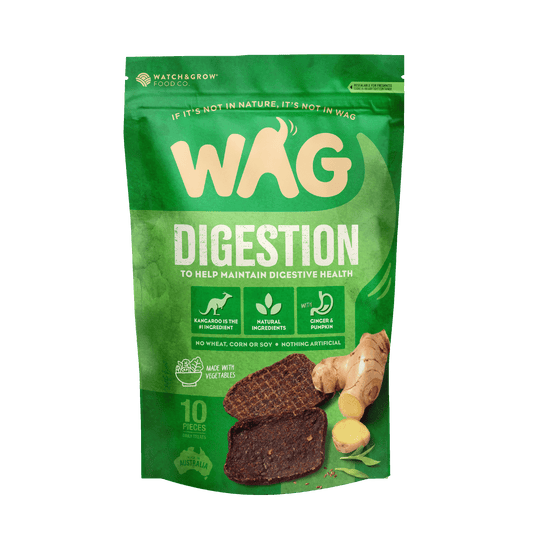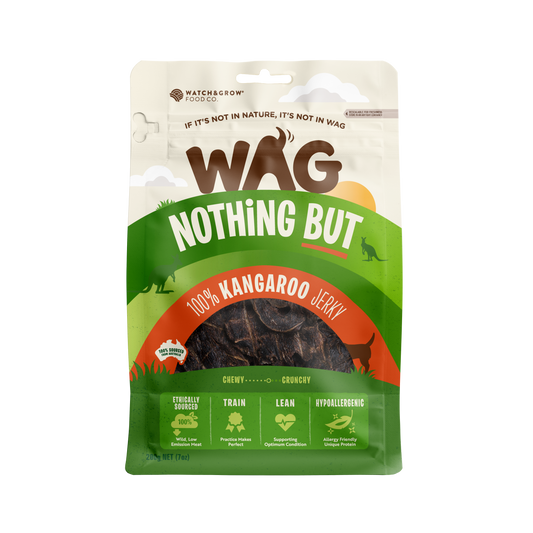Is feeding your dog kangaroo good for the environment, or is it bad? It’s a pretty simple question, with a simple (mostly) answer. But the dog world is rife with debate on more topics than we can count. Some more controversial than others, and some downright silly. For as long as we can remember, there’s always existed one debate that’s been consistent over time: what to feed your doggo, what to avoid, what kind of food is okay and what isn’t.
There’s no surprise that feeding kangaroo meat has attracted a ton of attention.
Is eating kangaroo wrong?
Eating kangaroo is nothing new for most Aussies. Indigenous Australians have been eating kangaroo for centuries, due to its accessibility and nutritional benefits. While it took some time for its popularity to catch on, kangaroo meat has become a staple in many Aussie barbecues and restaurants. And if you are looking to get your hands on some, there’s almost no digging necessary. Kangaroo meat can be easily found in Australian supermarkets everywhere, occasionally alongside other ‘alternative’ proteins like emu or crocodile.
But some people still shy away from the idea of digging into the cultural symbol that is kangaroo. While countries eating their national emblem is nothing new, many have shared their doubts on just how ethical it is to eat kangaroo. Whether it’s due to the way that kangaroos are caught and processed, conservation methods, methane production or more, you’ve probably heard of vocal groups sharing their concerns about whether kangaroo meat is really fine to eat.
How is feeding your dog kangaroo good for the environment?
The benefits of eating kangaroo are substantial. But more than that – kangaroo meat is one of the most environmentally conscious choices you can make when picking your dog’s food.
Reduced environmental impact
Traditional sources of meat like beef and chicken have come under fire in recent years for their environmentally unfriendly emissions. With approximately 14% of emissions coming from the production and processing of livestock, it makes sense that consumers have started looking elsewhere for sustainable protein choices.
But experts think they might have the answer. Due to the unique way that Kangaroos digest their food – a tricky process where they ferment food in their gut before passing it – they produce less methane gas than their traditionally farmed counterparts. Kangaroos also boast a much lower use of resources than traditional livestock like sheep: 13% less water, and eating just a third of the plant material regularly consumed by lamb.
Lastly, roos are much kinder to the landscape than their four-legged friends. Due to their soft pads instead of hooves, they cause far less degradation to the earth and erosion to the soil.

Conservation concerns
While some have expressed concern that the hunting and processing of Kangaroos for human (and canine!) consumption could threaten them as a species, experts disagree.
Kangaroo populations in Australia sit somewhere between 42-50 million – that’s double the number of humans! This overpopulation is spread across all states, with 14.5 million kangaroos in NSW alone. The land is proving just not fertile enough to feed such an enormous population of herbivores.
This grazing pressure means many kangaroos don’t receive adequate nutrition, with others (the weaker, younger and older) often starving from malnutrition. As they struggle to find enough resources for their enormous herds, kangaroos begin encroaching on Aussie farmer’s lands, competing with their sheep and cattle for what little remaining water and food they can find.
To combat this, the Australian government devised a quota for the number of kangaroos hunted for consumption each year. To make sure that culling is kept to an appropriate minimum, this quota is annually reviewed with reference to the total population of kangaroos, and then adjusted accordingly.
The number of roos to be culled each year is never made arbitrarily. According to the ACT Government, the number is closely “reviewed by government ecologists, and adjusted… to compensate for environmental variables such as rainfall and pasture growth.”
What does the RSPCA say about kangaroo culling?
Here is the statement made by the RSPCA on the subject:
RSPCA Australia believes that the issue of whether kangaroos and wallabies should continue to be killed under a sustainable use policy should be reviewed by both federal and state/territory governments.
The RSPCA takes the position that allowing the harvest of a set percentage of the wild kangaroo population is determined against the current government regulations. Meaning on an annual basis, with reference to the aerial population survey. That number is never more than 20% of the total population.
Kangaroos are never farmed
Did you know that kangaroo are 100% wild?
Kangaroos can’t be domesticated. There are zero facilities to farm and process them the same way we do traditional livestock. Kangaroos live wild and free, traversing the Aussie outback of their own volition, living in huge herds and traveling enormous distances each day. Not a single pound of kangaroo protein you see on supermarket shelves have been farmed. All of it wild-caught by professional and licensed hunters.
Kangaroos are culled by expert marksmen. These hunters operate under special harvesting programs, regulated by the Australian government. These regulations have made it as difficult as possible for individuals to inhumanely hunt a kangaroo and still profit off them – with Abattoirs going so far as to reject kangaroo that were not euthanised with an immediate and lethal shot.
While this may not sound extremely pleasant to us, it’s actually considered one of the most humane ways for an animal to be processed for human (and canine!) consumption. And according to the RSPCA’s chief scientist, the process of hunting wild-caught kangaroo “is way better than that of most intensively farmed animals.”
Does your dog do Roo?
Eating kangaroo meat has always been pursued by controversy. It’s more than understandable to baulk at the idea the first time you hear it. But digging deeper into the facts about kangaroo meat can make the decision much clearer.
Feeding kangaroo is good for the environment, but it’s so much more. It’s one of the most ethical ways you and your doggo can get your protein fix. It reduces strain on the atmosphere with hugely reduced greenhouse gases and methane. It’s one of the most humane ways an animal can be slaughtered and processed for consumption. And, last but not least, it’s really, really good for you.
Shop the Recipe
WAG Team
Up Next
The best treats for dogs with allergies




